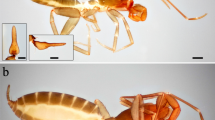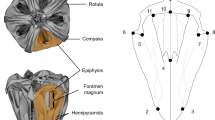Abstract
Fourier analysis of shape provides a unique means of studying morphologic variation of bivalves, especially in terms of their evolution and autecology. Amplitude spectra resulting from analysis may be refined, summarized, and further evaluated by a series of statistical measures designed to extract the maximum amount of information from outline features. Root mean square error comparison of harmonics, combined with a modified analysis of variance design and Snedecor's F-test, permits identification of significant amplitudes. Intra- and interspecific variation may be expressed as variance about mean power estimates derived from significant amplitudes for each species. Variance estimates of 14 species of heterodont bivalves indicate that venerid bivalves show considerably more intraspecific shape variability than do tellinid species. In both groups, however, species characterized by more elongate shells show less intraspecific variability. Evolutionary and environmental implications of interspecific shape variance in bivalves suggest that future comprehensive examination of specimens, collected in situ, may be fruitful.
Similar content being viewed by others
References
Anstey, R. L., and Delmet, D. A., 1973, Fourier analysis of zooecial shapes in fossil tubular bryozoans: Geol. Soc. America Bull., v. 84, no. 5, p. 1753–1764.
Boss, K. J., 1966, The sub-family Tellininae in the western Atlantic: The generaTellina (Part II) andTellidora: Johnsonia, Department of Molluscs, Museum of Comparative Zoology, Harvard University, Cambridge, Massachusetts, v. 4, no. 46, p. 273–344.
Chapman, S., and Bartels, J., 1962, Geomagnetism, v. II: Clarendon Press, Oxford, England, p. 543–911.
Churchill, R. V., 1941, Fourier series and boundary value problems: McGraw-Hill Book Co., New York, 206 p.
Davis, J. C., 1973, Statistics and data analysis in geology: John Wiley & Sons, Inc., New York, 550 p.
Ehrlich, R., and Weinberg, B., 1970, An exact method for characterization of grain shape: Jour. Sed. Pet., v. 40, no. 1, p. 205–212.
Harbaugh, J. W., and Merriam, D. F., 1968, Computer applications in stratigraphic analysis: John Wiley & Sons, Inc., New York, 282 p.
Kaesler, R., and Waters, J. A., 1972, Fourier analysis of the Ostracode margin: Geol. Soc. America Bull., v. 83, no. 4, p. 1169–1178.
Kaufman, E. G., 1969, Form, function and evolution,in Treatise on invertebrate paleontology, Part N, Mollusca 6, Bivalvia: Univ. Kansas Press, Lawrence, p. N1–N489.
Krumbein, W. C., and Greybill, F. A., 1965, An introduction to statistical models in geology: McGraw-Hill Book Co., Inc., New York, 475 p.
Lanczos, C., 1956, Applied analysis: Prentice-Hall, Inc., Englewood Cliffs, 539 p.
Lee, Y. W., 1960, Statistical theory of communication: John Wiley & Sons, Inc., New York, 509 p.
MacGinitie, G. E., 1935, Ecological aspects of a California marine estuary: Am. Midland Naturalist, v. 16, no. 5, p. 629–765.
Ross, D. T., 1957, Sampling and quantizing,in Notes on analog—digital conversion techniques: The Technology Press, Cambridge, Massachusetts, p. 2-1–2-72.
Schwarcz, H. P., and Shane, K. C., 1969, Measurement of particle shape by Fourier analysis: Sedimentology, v. 13, no. 3/4, p. 213–231.
Simpson, G. G., 1949, The meaning of evolution: Yale Univ. Press, New Haven, 364 p.
Stanley, S. M., 1970, Relation of shell form to life habits of the Bivalvia (Mollusca): Geol. Soc. America Mem. 125, 296 p.
Thomas, G. B., Jr., 1971, Calculus and analytical geometry (alternate ed.): Addison-Wesley Publ. Co., Inc., Reading, Massachusetts, 1034 p.
Waller, T. R., 1969, The evolution of theArgopecten gibbus stock (Mollusca: Bivalvia), with emphasis on the Tertiary and Quaternary species of eastern North America: The Paleontological Society Mem. 3, 125 p.
Warme, J. E., 1971, Paleoecological aspects of a modern coastal lagoon: Univ. California, Publ. Geological Sciences, v. 87, 131 p.
Wylie, C. R., Jr., 1966, Advanced engineering mathematics: McGraw-Hill Book Co., Inc., New York, 799 p.
Author information
Authors and Affiliations
Rights and permissions
About this article
Cite this article
Gevirtz, J.L. Fourier analysis of bivalve outlines: Implications on evolution and autecology. Mathematical Geology 8, 151–163 (1976). https://doi.org/10.1007/BF01079032
Received:
Issue Date:
DOI: https://doi.org/10.1007/BF01079032




